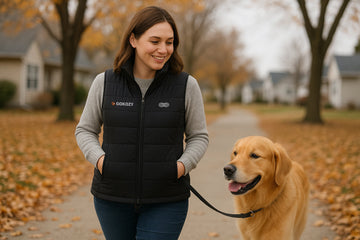Many shoppers wonder what happens when a heated vest runs out of power. Does it instantly become useless—or does it still keep you warm? The short answer: a heated vest without its battery still works as a normal insulated layer, but you lose the active heat boost that makes it stand out in cold or windy conditions.
What Happens When the Battery Runs Out?
Passive warmth vs. active heat
Even without a battery, a heated vest remains an insulated garment made from shell fabrics, lining, and often lightweight padding. That means it can still trap your body heat (passive insulation). What you lose is the steady, targeted warmth generated by the heating elements (active heating) across the chest, back, and collar.

Realistic expectations
Think of it like this: without power, the vest performs like a light to mid-weight gilet. With power, it works like that same vest plus a built-in, controllable heat source—especially useful when you’re sitting still, facing strong winds, or outdoors for long stretches.
When a Battery-Free Heated Vest Is Still Useful
- Mild days and short trips: Quick errands, school runs, or commutes where you don’t need continuous heating.
- Indoors or in vehicles: Offices, workshops, stadium seating, or trains where temperatures fluctuate.
- As a layering piece: It still adds wind resistance and helps trap base-layer warmth under a shell.

How Long Do heated vests Stay Warm With a Battery?
Typical runtime ranges
Runtime depends on battery capacity and heat level. Many modern heated vests offer approximately:
- High: 3–4 hours (fast warm-up, strongest heat)
- Medium: 5–7 hours (balanced comfort)
- Low: 8–10 hours (maximum endurance)
Cold outdoor conditions can reduce battery efficiency, so keeping the power bank close to your body (or under a shell) helps maintain runtime.
Best Layering If You’re Low on Power
Trap your own heat first
- Base layer: Moisture-wicking, close-fit top (synthetic or merino). Avoid bulky cotton.
- Heated vest: Fit should be snug, not tight, so warmth transfers directly to the core.
- Wind-blocking shell: A lightweight softshell or rain jacket over the vest prevents wind from stripping heat.
Tips to Maximise Comfort Without Power
- Zip up: Close the vest and your outer shell to reduce drafts around the collar and hem.
- Smart venting: If you start to sweat, open briefly to stay dry—damp layers feel colder later.
- Keep the battery warm: If you still have power, store the pack in an inner pocket and start on High for a few minutes, then step down to Medium/Low.
- Carry a spare: A second power bank lets you enjoy all-day heated comfort.

Common Questions
Does a heated vest feel cold without the battery?
No. It behaves like a normal, lightly insulated vest. You simply won’t feel the extra heat from the heating zones.
Is it worth wearing without power?
Yes—on mild days, in light wind, or for short trips, you’ll still benefit from wind resistance and insulation. For colder, longer outings, bring a charged battery or a spare.
What’s the best single upgrade for warmth?
A windproof outer shell. Even a thin shell over your heated vests dramatically reduces heat loss—battery or not.
Final Thoughts
Without a battery, a heated vest still functions as a lightweight, practical insulating layer. With a battery, it becomes a controllable heat source that smooths out the coldest parts of your day. For reliable all-day warmth, combine smart layering with a fully charged pack—and consider carrying a spare for peace of mind.






